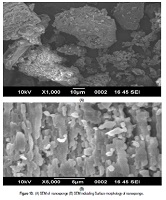Formulations and evaluation of Cyclodextrin complexed Ceadroxil loaded nanosponges
Keywords:
Cefadroxil, cyclodextrins, nanosponges, paracrystallineAbstract
Cefadroxil (CFD) is a broad spectrum antibiotic that acts against an extensive variety of bacteria, including Gram-positive and Gram-negative bacteria. The major drawback of orally administered drug like cefadroxil is its shorter half life of 1.2 hrs. The goal of the study is to prolong the drug release, producing a desired blood serum level, reduction in drug toxicity and improving the patient compliance by prolonging the dosing intervals. Cyclodextrin-based nanosponges (NS) are a novel class of cross-linked derivatives of cyclodextrins. They have been used to increase the solubility of poorly soluble actives, to protect the labile groups and control the release. This study aimed at formulating complexes of CFD with three types of β-cyclodextrin NS obtained with different crosslinking ratio (viz. 1:2, 1:4 and 1:8 on molar basis with the cross-linker) to protect the lactone ring from hydrolysis and to prolong the release kinetics of CFD. Crystalline (F1:2, F1:4 and F1:8) and paracrystalline NS formulations were prepared. XRPD, DSC and FTIR studies confirmed the interactions of CFD with NS. XRPD showed that the crystallinity of CFD decreased after loading. CFD was loaded as much as 21%, 37% and 13% w/w in F1:2 , F1:4 and F1:8, respectively while the paracrystalline NS formulations gave a loading of about 10% w/w or lower. The particle sizes of the loaded NS formulations were between 450 and 600 nm with low polydispersity indices. The zeta potentials were sufficiently high (-20 to -25 mV) to obtain a stable colloidal nanosuspension. The in vitro studies indicated a slow and prolonged CFD release over a period of 24 h. The NS formulations protected the lactone ring of CFD after their incubation in physiological conditions at 37°C for 24 h with a 80% w/w of intact lactone ring when compared to only around 20% w/w of plain CFD.
References
. Loftsson T, Hreinsdottir D, Masson M. Evaluation of cyclodextrinsolubilization of drug, Intl. J. Pharm. 2005;302:18–28.
. Vyas A, Shailendra S, Swarnlata S. Cyclodextrin based novel drug delivery systems. J. Incl. Phenom. Macrocycl. Chem. 2008;62:23–42.
. Salmaso S, Semenzato A, Caliceti P, Hoebeke J, Sonico F, Dubernet C, Couvreur P. Specific antitumor targetable β-cyclodextrin-poly(ethylene glycol)-folic acid drug delivery bioconjugate,Bioconjug. Chem. 2004;15:997–1004.
. Giammona G, Cavallaro G, Maniscalco L, Craparo EF, Pitarresi G. Synthesis and characterization of novel chemical conjugates based on α,β-polyaspartylhydrazide and β-cyclodextrin,Eur. Polym. J. 2006;42: 2715–2729.
. Gomez CG, Chambat G, Heyraud A, Villar M, Auzély-Velty R. Synthesis and characterization of a β-CD-alginate conjugate, Polymer. 2006;47:8509–8516 (256).
. Ferruti P, Ranucci E, Trotta F, Gianasi E, Evagorou EG, Wasil M, Wilson G and Duncan R. Synthesis, characterization, and antitumor activity of platinum(II) complexes of novel functionalized poly(amido amine)s, Macromol. Chem. Phys. 1999;200: 1644–1654 .
. Garcia-Zubiri I X, Gonzales-Gaitano G and Isasi JR. Thermal stability of solid dispersions of naphatelene derivatives with β-cyclodextrin and β-cyclodextrin polymers, Termochim. Acta. 2006;444:57–64.
. Ma M and Li D. New organic nanoporous polymers and their inclusion complexes, Chem.Mater. 1999;11:872–876.
. Trotta F and Tumiatti W. Cross-linked polymers based on cyclodextrin for removing polluting agents, WO 03/085002 (2003).
. Cavalli R, Trotta F and Tumiatti V. Cyclodextrin-based nanosponges for drug delivery, J. Incl. Phenom. Macrocycl. Chem. 2006;56: 209–213.
. Swaminathan S, Vavia P R, Trotta F and Torne S. Formulation of betacyclodextrin based nanosponges of itraconazole, J. Incl. Phenom. Macrocycl. Chem. 2007;57: 337–341.
. Trotta F. Cyclodextrinnanosponges: a new material in supramolecular chemistry Inorganic, Physical and Materials Chemistry Department, University of Torino.
. Sharma R, Pathak K. Polymericnanosponges as an alternative carrier for improved retention of econazole nitrate onto the skin through topical hydrogel formulation. Pharm Dev Technol. 2010
. Torne SJ, Ansari KA, Vavia PR, Trotta F, Cavalli R. Enhanced oral paclitaxel bioavailability after administration of paclitaxel loaded nanosponges. Drug Deliv. 2010;17(6):419–25.
. Hu CM, Fang RH, Copp J, Luk BT, Zhang L. A biomimetic nanosponge that absorbs pore-forming toxins. Nature nanotechnology. 2013 ;8(5):336-40.
. Srinivas P. Formulation and evaluation of voriconazole loaded nanosponges for oral and topical delivery. International Journal of Drug Development and Research. 2013.
. Wang F, Gao W, Thamphiwatana S, Luk BT, Angsantikul P, Zhang Q, Hu CM, Fang RH, Copp JA, Pornpattananangkul D, Lu W. Hydrogel Retaining Toxin‐Absorbing Nanosponges for Local Treatment of Methicillin‐Resistant Staphylococcus aureus Infection. Advanced Materials. 2015 ;27(22):3437-43.
. Trotta F, Tumiatti W. Cross-linked polymers based on cyclodextrin for removing polluting agents. WO 03/085002; 2003.
. Trotta F, Cavalli R. Characterization and applications of new hypercross-linked cyclodextrins. Compos Interface. 2009;16:39–48.
. http://www.lanl.gov/news/index.php/fuseaction/home.story/story_id/1631. nanosponges soak up contaminants and cut cleanup costs
. Cavalli R, Trotta F, Tumiatti W. Cyclodextrin-based nanosponges for drug delivery. J InclPhenomMacrocycl Chem. 2006;56:209–213.
. Trotta F, Tumiatti W, Cavalli R, Zerbinati O, Roggero CM, Vallero R. Ultrasound-assisted synthesis of cyclodextrin based nanosponges. Patent number WO 06/002814 (2006)
. Mele Andrea, Castiglione Franca, Malpezzi Luciana, Ganazzoli Fabio, RaffainiGiuseppina, Trotta Francesco, Rossi Barbara, Fontana Aldo, Giunchi Giovanni.HR MAS NMR, powder XRD and Raman spectroscopy study of inclusion phenomena in β CD nanosponges.JInclPhenomMacrocyclChem; 2010.
. Sharma MC, Sharma S. Studies on the preparation, characterization, solubility and stability of cefadroxil β-cyclodextrin inclusion complexes. Journal of optoelectronics and advanced materials: 2010; 12(2): 411-415.
. Indian pharmacopoeia, published by Indian pharmacopoeia commission, 1996.
. Drug bank , available from, URL; http:/www.drugbank.ca/drugs/DB01140
. www.fao.org/ag/agn/jecfa-additives/specs.
. www.inchem.org/documents/sids/sids/102090.pdf
. Aminabhavi TM. Development of chitosan-guar gum semi-interpenetrating Polymer network microspheres for controlled release of cefadroxil. Designed monomers and polymers, 2006; 9(5):491–501.
. www.accesssdata.fda.gov/scripts/cder/onctools/animalresults.cfm






